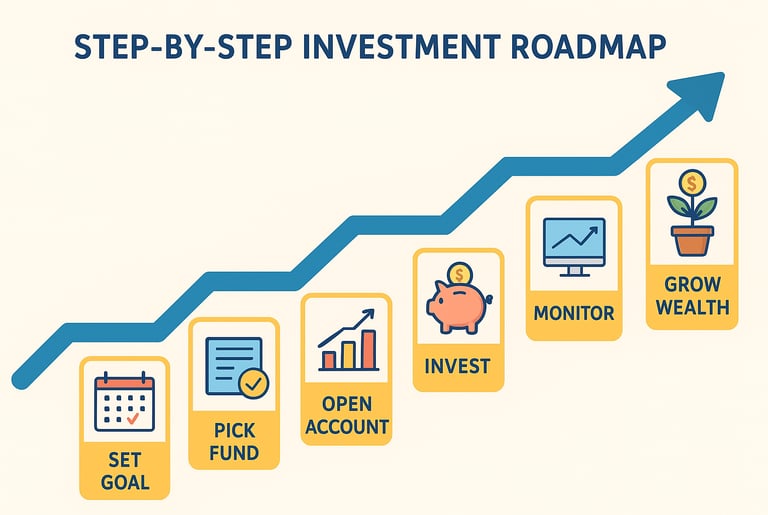Understanding Index Funds: A Guide to Long-Term Investing
Explore our blog on index funds, a top investing strategy for beginners and experts. Learn how index funds work, track the stock market, and outperform most trading methods. Start your Journey towards financial freedom now!
9/27/20254 min read


Understanding Index Funds
Ever wish you could invest in Apple, Amazon, Google, and 497 other giant companies — without needing a billionaire’s wallet? That’s exactly what an index fund does. Instead of betting on one stock, it spreads your money across a whole market index, like the S&P 500 which represents the top 500 performing companies in the US. Think of it as ordering the entire menu instead of stressing over which dish to pick.
Here’s why people love them: they’re simple, cheap, and historically effective. If you invested just $200 a month from your 20's till your 60's, history suggests you’d walk away with over $1 million — not bad for skipping a few Netflix subscriptions and every day coffees.
How Index Funds Work and Their Benefits
Index funds are a type of mutual fund or exchange-traded fund (ETF) designed to replicate the performance of a specific market index. The mechanics behind index funds involve passive management, where the fund manager's primary goal is to mirror the holdings of the chosen index rather than actively selecting investments. This strategy typically involves purchasing all or a representative sample of the securities that compose the index, allowing the fund to reflect the same risks and returns as the underlying market.
Benefits:
Low fees: Less trading and research means more of your money stays invested.
Diversification: Your money spreads across many companies, reducing risk.
Steady long-term growth: Historically, they perform well over time, often better than most actively managed funds.
In short, index funds are an easy, low-stress way for beginners to invest, grow wealth, and minimize risk.
Comparing Index Funds to Other Investment Options
Not all investments are created equal. Some promise big rewards but come with bigger risks, while others are simple and steady. Before you put your money to work, it helps to understand the main options — index funds, individual stocks, and actively managed funds — and how they compare. Here’s a quick breakdown to see which one fits your goals and style.
Index Funds: These mirror a market index, like the S&P 500. They are passively managed, low-cost, and highly diversified, spreading your money across hundreds of companies. Risk is lower because your investment isn’t tied to a single stock, and returns generally match the market over time. Best for beginners or hands-off investors.
Individual Stocks: You pick specific companies to invest in. Potential returns can be very high, but so can losses. Requires knowledge of companies, industries, and market trends. Risk is higher because your success depends on a few stocks. Best for experienced, risk-tolerant investors.
Actively Managed Funds: Professional managers try to beat the market by picking stocks and adjusting allocations. Fees are higher, and while returns can exceed the market, most funds fail to outperform consistently. Best for investors willing to pay for professional management but aware of the risks.
Summary: Index funds are simple, low-cost, and diversified, making them ideal for long-term growth. Individual stocks offer higher potential but more risk. Actively managed funds may outperform but usually come with higher fees and inconsistent results.
Getting Started: A Step-by-Step Guide to Investing in Index Funds
Ready to grow your wealth? Investing in index funds is easier than you think. Follow these simple steps, start small, stay consistent, and let your money work for you.
Step 1: Define Your Goal
Decide why you’re investing. Are you saving for retirement, a big purchase, or building long-term wealth? Your goal helps determine how much to invest and which funds to choose.
Step 2: Choose the Right Index Fund
Pick a fund that matches your goal and risk tolerance. Examples include:
S&P 500 index fund – tracks 500 large U.S. companies.
Total stock market fund – broader exposure across U.S. companies.
International index fund – exposure to global markets.
Step 3: Open a Brokerage Account
Select a reputable brokerage (Vanguard, Fidelity, Schwab, or an online app). Look for low fees, easy fund access, and helpful tools for beginners.
Step 4: Decide How Much to Invest
Start small or at a comfortable monthly amount. Even skipping one coffee a week can grow into serious money over decades. Consistency is more important than the exact number.
Step 5: Set Up Automatic Contributions
Automate your investments to make saving effortless. Dollar-cost averaging helps reduce the impact of market ups and downs.
Step 6: Monitor Occasionally, Don’t Obsess
Check your investments periodically, but avoid frequent trading. Index funds are designed for the long term, so patience pays off.
Step 7: Stay Consistent and Let Compounding Work
The magic of index funds comes from long-term growth and compounding. Stick to your plan, keep contributing, and watch your wealth grow over time.
Summary
Investing doesn’t have to be complicated to be powerful. Index funds give you a simple, low-cost, and diversified way to grow your wealth steadily over time. By spreading your money across hundreds of companies, you reduce risk while letting compound interest do its magic. Whether you’re just starting with $200 a month or planning for a long-term goal, consistency and patience are your strongest tools. Start today, stay consistent, and watch your small steps turn into big financial milestones — the path to financial freedom begins with smart, steady investing.






Inspiration
Empowering your journey to financial freedom.
Contact us
Explore
contact@thirst4success.com
© 2025. All rights reserved.
Disclaimer: The information provided is for educational and informational purposes only and should not be construed as professional, financial, investment, or legal advice. You should consult with a qualified professional before making any decisions based on this information. We make no guarantees about the accuracy, completeness, or suitability of this content for your particular situation. Use of this information is at your own risk.
